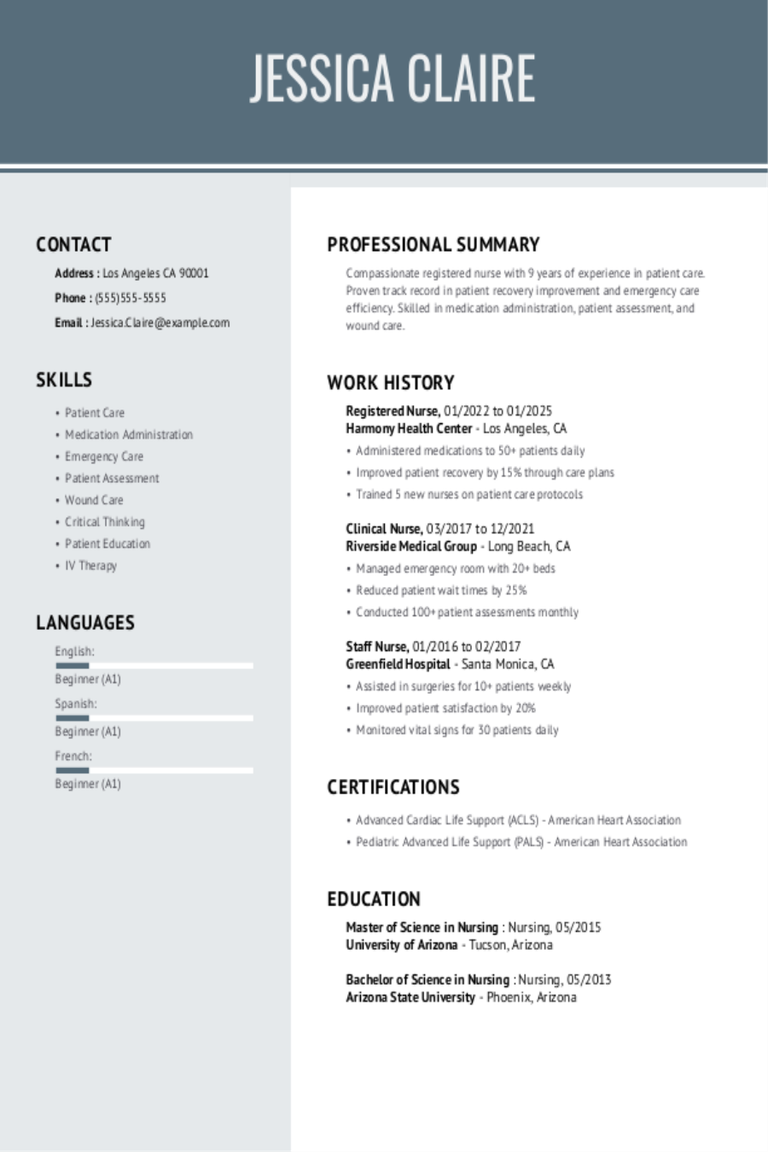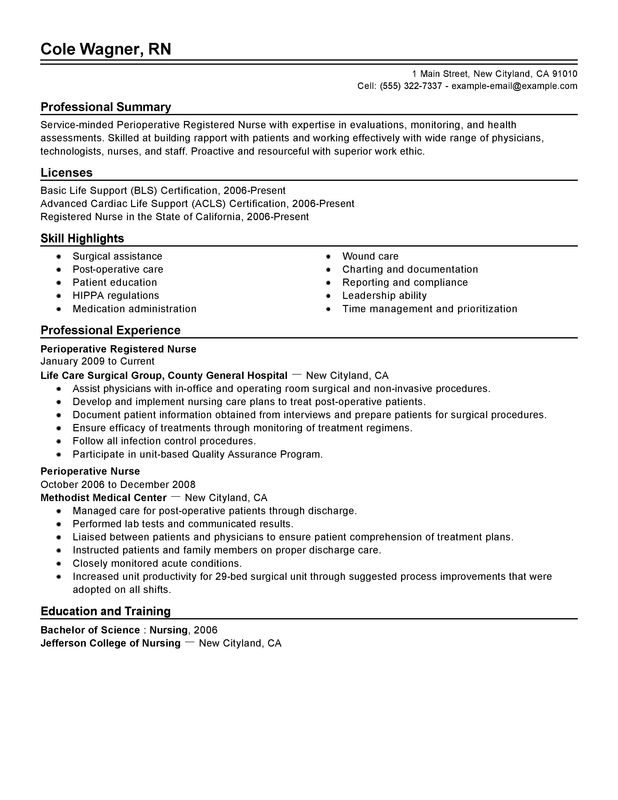Why this resume works
- Highlights industry-specific skills: The applicant seamlessly integrates nursing skills, showcasing a robust background in patient care and clinical leadership within various healthcare settings.
- Quantifies accomplishments: Metrics like “administered medications to 50+ patients daily” and “reduced patient wait time by 15%” underscore the job seeker’s tangible impact on patient care.
- Uses action-oriented language: Action verbs like “administered,” “managed,” and “implemented” effectively engage the reader, emphasizing proactive contributions in healthcare roles.
More Licensed Practical Nurse Resume Examples
Our licensed practical nurse resume examples provide valuable guidance on showcasing your patient care, clinical skills, and medical knowledge. Use these samples to create a standout nursing resume that emphasizes your talent and dedication.
Entry-level Licensed Practical Nurse
Why this resume works
- Features education section prominently: The education section is placed near the top of the resume to showcase credentials above work experience. This is a smart strategy when you’re just getting started in your career.
- Uses a resume objective: This resume begins with an objective statement rather than the more traditional professional summary. Resume objectives are perfect early in your career when you need to describe your goals.
- Shows digital literacy: Key computer skills are showcased through experience with electronic medical records systems. These demonstrate a readiness for modern healthcare environments.
Mid-level Licensed Practical Nurse
Why this resume works
- Demonstrates language abilities: The resume illustrates language skills by detailing fluency in English, Spanish, and French, emphasizing effective cross-cultural communication and international project collaboration.
- Hones in on real impact: Specific achievements like a 20% improvement in patient satisfaction and reduced onboarding time by 30% highlight the candidate’s real impact on their workplaces.
- Displays technical expertise: Technical expertise is shown through extensive skills such as IV therapy, electronic medical records proficiency, and advanced certifications from the American Heart Association.
Experienced Licensed Practical Nurse
Why this resume works
- Lists relevant certifications: Certifications like BLS, CPR, and ACLS are prominently listed, reflecting a strong commitment to expertise and ongoing professional development in nursing.
- Showcases impressive accomplishments: Achievements such as improving patient satisfaction by 20% and reducing medication errors by 15% clearly indicate a significant positive impact at senior levels.
- Sections are well-organized: The resume uses bullet points and clear headers effectively, making it easy to scan through work experience, education, skills, and accomplishments.
Licensed Practical Nurse Resume Template (Text Version)
Amanda Turner
Miami, FL 33139
(555)555-5555
Amanda.Turner@example.com
Professional Summary
Dedicated LPN with exceptional patient care skills, proficient in medication administration, and a proven track record of improving patient satisfaction scores. Expert in managing electronic medical records and delivering effective patient education.
Skills
- Patient Care
- Medication Administration
- Vital Signs Monitoring
- Electronic Medical Records
- Wound Care Management
- Infection Control
- Patient Education
- Clinical Supervision
Certifications
- Basic Life Support (BLS) – American Heart Association
- Advanced Cardiac Life Support (ACLS) – American Heart Association
Education
Master of Science in Nursing Nursing
University of Illinois Chicago, Illinois
June 2017
Bachelor of Science in Nursing Nursing
Illinois State University Normal, Illinois
June 2015
Work History
Licensed Practical Nurse
Harmony Health Center – Miami, FL
March 2023 – March 2025
- Administered medications to 50+ patients daily
- Managed patient records with 100% accuracy
- Trained 10 new nurses on patient care protocols
Clinical Nurse
Meadowbrook Clinic – Hialeah, FL
March 2019 – February 2023
- Provided care to 30+ patients in a surgical unit
- Reduced patient wait time by 15%
- Implemented new infection control procedures
Healthcare Assistant
Riverside Medical Group – Fort Lauderdale, FL
March 2017 – February 2019
- Assisted with daily living activities for 20 patients
- Maintained a clean and safe patient environment
- Conducted routine vital signs checks accurately
Languages
- English – Beginner (A1)
- Spanish – Beginner (A1)
- French – Beginner (A1)
Popular Skills for a Licensed Practical Nurse Resume
Highlighting a strong resume skills section is critical for demonstrating the technical abilities and soft skills needed to thrive as a licensed practical nurse. Essential skills such as patient care, medical knowledge, empathy, and communication are vital for delivering outstanding healthcare.
Below are a few of the top soft skills frequently listed on licensed practical nurse resumes.
| Soft Skills | % of resumes with this skill |
|---|---|
| Patient care | 25.91% |
| Compassionate care | 25.72% |
| Multi-tasking and prioritization | 25.71% |
| Empathy and compassion | 21.21% |
| Family communication | 19.62% |
Here are a few examples of hard skills frequently included on licensed practical nurse resumes.
| Hard Skills | % of resumes with this skill |
|---|---|
| HIPAA compliance | 69.44% |
| Direct patient care | 69.41% |
| Medication administration | 67.32% |
| Vital signs monitoring | 61.85% |
| Wound care | 38.69% |
Related Resume Guides
- Geriatric Nurse Practitioner
- Hemodialysis Nurse
- Intensive Care Nurse
- Labor And Delivery Nurse
- Neonatal Nurse
- NICU Nurse
- Nurse Anesthetist
- Nurse Practitioner
- Nursing Aide And Assistant
- Nursing Assistant
- Nursing Unit Clerk
- OB Gyn Nurse
- Oncology Nurse
- Operating Room Nurse
- Patient Care Associate
- Patient Care Technician
- Pediatric Nurse
- Perioperative Nurse
- Pre Post Operating Nurse
- Private Duty Nurse
- Public School Nurse
- Registered Nurse
- Shift Coordinator
- Trauma Nurse
Advice for Writing Your Licensed Practical Nurse Resume
Need help figuring out how to make a resume for a licensed practical nurse job? We’ve got you covered. Learn how to show off your skills, experience, and passion for patient care in a way that stands out. These tips are made just for LPNs, so you can create a strong resume and move forward in your nursing career with confidence.
Write a strong professional summary
A professional summary serves as a concise and engaging introduction at the top of your resume, spotlighting your core skills and experiences as a licensed practical nurse. Summaries are a snapshot of the value you’ve brought to previous roles and a showcase of your achievements and expertise.
Less-experienced job seekers may be better suited for a resume objective. Objectives lay out your goals and explain how your skills would apply to a future role. Whichever approach you choose, prioritize your most relevant qualifications to ensure that even a quick scan reveals why you are an ideal candidate for the position.
Licensed practical nurse resume summary examples
Entry-level
Compassionate and dedicated recent graduate with an Associate’s Degree in Nursing (ADN) and licensed as a practical nurse (LPN). Possesses strong foundational skills in patient care, medication administration, and vital sign monitoring. Certified in Basic Life Support (BLS) and eager to contribute to a dynamic healthcare team while providing high-quality care to patients.
Mid-career
Detail-oriented licensed practical nurse with over 5 years of experience in long-term care and hospital settings. Proven expertise in wound care management, patient education, and chronic disease management. Adept at implementing physician orders, monitoring patient progress, and ensuring adherence to healthcare protocols. Recognized for excellent clinical skills, teamwork, and dedication to patient welfare.
Experienced
Highly skilled licensed practical nurse with 15+ years of comprehensive experience in various healthcare environments including acute care, geriatrics, and home health. Demonstrates exceptional leadership abilities by mentoring junior staff and leading quality improvement initiatives. Certified IV Therapy Specialist with a track record of enhancing patient outcomes through evidence-based practices. Committed to delivering compassionate care while maintaining the highest standards of nursing excellence.
Licensed practical nurse resume objective examples
Recent graduate
Compassionate and dedicated recent graduate with a licensed practical nurse (LPN) certification seeking an entry-level position to deliver high-quality patient care. Eager to apply clinical knowledge and skills in a healthcare setting, while contributing to the well-being and recovery of patients.
Career changer
Motivated professional transitioning into the nursing field as a licensed practical nurse (LPN), bringing strong interpersonal skills and a solid foundation in patient care from previous healthcare roles. Committed to providing empathetic and effective care to support patient health and recovery.
Specialized training
Licensed practical nurse (LPN) with specialized training in geriatric care seeking an entry-level position at a long-term care facility. Passionate about utilizing my skills in elderly patient care and chronic disease management to enhance the quality of life for residents through compassionate and personalized nursing practices.
Use our Resume Builder to easily create a polished resume. It offers a range of templates that highlight your skills and experiences as a nurse.
Include relevant certifications and training
Listing your credentials such as certifications, licenses, and specialized training is crucial, especially in technical fields like nursing. It shows employers that you have the required skills and knowledge to perform your job well. For a licensed practical nurse (LPN), having these credentials can set you apart from other candidates and demonstrate your commitment to ongoing education.
Create a dedicated Certifications section on your resume and list your credentials prominently. This can be an enhancement alongside your education section. Examples of relevant certifications for an LPN include:
- Basic Life Support (BLS)
- Advanced Cardiovascular Life Support (ACLS)
- IV Therapy Certification
- Wound Care Certification
Make sure to list each certification clearly with the name of the certifying body and the date it was obtained or will expire. This organization makes it easy for employers to see that you meet their requirements at a glance.
Example of a certifications section
Licensed Practical Nurse (LPN)
Issued by: State Board of Nursing
Issued 2022
Basic Life Support (BLS)
Issued by: American Heart Association
Expires 2024
IV Therapy Certification
Issued by: National Federation of Licensed Practical Nurses (NFLPN)
Issued 2021
Phlebotomy Certification
Issued by: National Healthcareer Association (NHA)
Expires 2023
A combination resume format is great if you need to highlight certifications that are essential for the job. It puts your skills and credentials up front while still showcasing your experience, making it easier for employers to see that you meet their requirements.
Showcase your work experience
For a licensed practical nurse, featuring work experience on your resume is essential. Work experience shows prospective employers how you’ve applied practical skills in real-life scenarios. By listing your work experience in reverse chronological order, you highlight the most recent and pertinent details first, aiding hiring managers in quickly evaluating your qualifications.
When detailing your work history, begin with your job title, then the employer’s name, location, and employment dates. Describe your duties and achievements with clear, action-oriented bullet points.
5 licensed practical nurse work history bullet points
- Administered medications and treatments to 25+ patients daily, ensuring 98% adherence to prescribed schedules.
- Conducted comprehensive patient assessments, identifying early signs of complications and improving patient outcomes by 15%.
- Collaborated with a multidisciplinary team to develop and implement individualized care plans, enhancing patient satisfaction scores by 20%.
- Educated patients and families on disease management and post-hospitalization care, reducing readmission rates by 10%.
- Maintained accurate and detailed patient records, achieving a 99% compliance rate with regulatory documentation standards.
Using the correct keywords from the job ad helps your resume get through applicant tracking systems (ATS) and grab recruiters’ attention.
Match your resume with the job description
Customizing your resume to match job descriptions is essential because it helps you stand out to employers and increases your chances of passing through Applicant Tracking Systems (ATS). Employers use ATS software to scan resumes for specific terms, so using these keywords can help ensure your resume gets noticed. Your goal is to create an ATS-friendly resume.
Begin by finding key phrases and skills in the job description for a licensed practical nurse. Look for repeated words or specific qualifications. For example, if the job description mentions “patient care,” “medication administration,” and “vital signs monitoring,” make sure these terms are included in your resume.
Incorporate those keywords into your resume by rephrasing them into bullet points. For instance, if the job posting states, “Administer medications and monitor patient responses,” you could write: “Administered medications and closely monitored patient responses to ensure safety.” This not only matches the job description but also clearly showcases your experience.
From Work Experience to your Skills section, the rest of your resume should also include keywords from the job ad. This targeted approach makes it easier for hiring managers to see why you’d be a strong candidate.
Use our ATS Resume Checker to get instant feedback and make your resume stand out. It helps you match job keywords so that hiring managers notice you!
FAQ
Do I need to include a cover letter with my licensed practical nurse resume?
Enhancing your licensed practical nurse resume with a cover letter can be pivotal by emphasizing your genuine interest in the role and aligning your experience with job requirements.
A thoughtfully written cover letter allows you to share personal stories about patient care, convey your enthusiasm for nursing, and highlight any unique qualifications or experiences that distinguish you. For example, if you’ve handled high-stress situations like emergency rooms or possess specialized training pertinent to the position, make sure to include those details.
Customizing each cover letter demonstrates to employers that you’re sincerely interested and not merely sending out generic applications. Ultimately, it’s an opportunity to leave a lasting impression beyond the information on your resume. For guidance on crafting such letters, you can use our Cover Letter Generator or refer to our library of cover letter examples.
How long should a licensed practical nurse’s resume be?
Licensed practical nurses should strive for a resume length of one page, making it easy for hiring managers to swiftly identify essential skills and experiences.
However, if you have substantial experience or highly pertinent certifications, a two-page resume is permissible. Emphasize your clinical abilities, patient care expertise, and relevant training or certifications. This strategy ensures a strong impact while maintaining clarity and brevity.
How do you write a licensed practical nurse resume with no experience?
Creating a resume with no experience as an LPN may seem challenging, but you have more assets than you realize.
Initially, prioritize your education. Highlight your nursing program, the institution’s name, your graduation date, and any accolades. Be sure to include your LPN licensure details along with any additional certifications such as CPR or IV therapy.
Then, make the most of your clinical rotations. These are crucial experiences that demonstrate your practical skills in actual healthcare environments. Describe each rotation by mentioning the facility name, dates, and specific responsibilities like patient care, medication administration, or collaborating with healthcare teams.
Remember to showcase relevant abilities. Even if you haven’t yet worked as an LPN, underline related experiences such as volunteering at clinics or working as a CNA. Accentuate transferable skills like patient care proficiency, medical terminology knowledge, and electronic health records expertise.
Finally, incorporate a section for soft skills — attributes like empathy, communication, and teamwork are vital in nursing and can distinguish you from others. Customize everything to exhibit your dedication to helping others and readiness to take on the role of an LPN.
Rate this article
Licensed Practical Nurse
Additional Resources

LPN Cover Letter Examples & Templates
Here are a few key tips to help you take your cover letter based on this free LPN cover letter sample to the next level. To begin with, you want

LVN Cover Letter Examples & Templates
While the free LVN cover letter sample above will get you off to a great start, here are some additional tips to keep in mind. You want to begin your

Intensive Care Nurse Cover Letter Example & Templates
The intensive care nurse operates under high stress conditions. In any intensive care nurse cover letter, you want to make it clear that not only are you experienced, but you

Registered Nurse Resume Examples & Templates
Explore top registered nurse resume examples that showcase your essential clinical skills. Learn how to effectively present your patient care experience and medical expertise to impress healthcare employers.Build my resumeImport

Perioperative Nurse Resume Examples & Templates
A job search can be overwhelming and even a little stressful, but with an excellent resume, you will find the perioperative nurse position you're looking for. Your resume is one

Charge Nurse Cover Letter Example & Templates
There are a few things you should remember when writing your version of this free charge nurse cover letter sample: length, tone, and content. First, in consideration of the hiring
